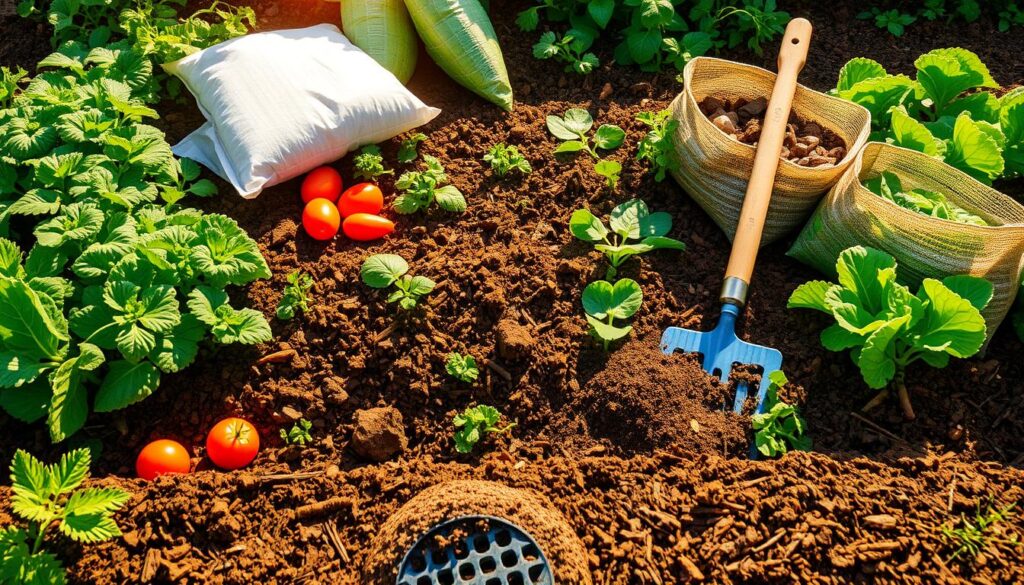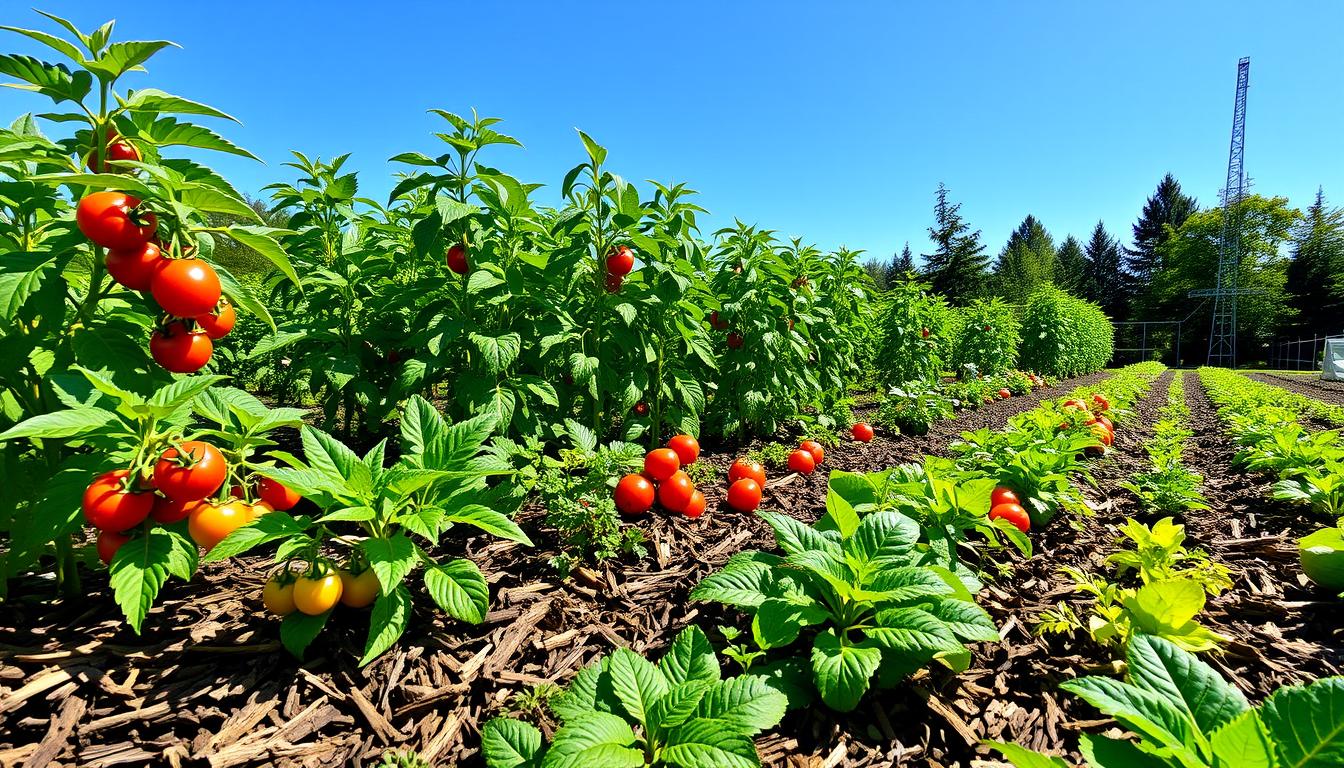Are you looking to improve your vegetable garden? This guide will show you how to use mulch to make your soil better, keep it moist, and increase your harvest. We’ll cover the different types of mulch, their benefits, and how to use them right in your garden.
Key Takeaways
- Mulch is a crucial element in maintaining a thriving vegetable garden.
- Different types of mulch offer unique advantages for your garden’s needs.
- Proper application and maintenance of mulch can significantly enhance soil health and moisture retention.
- Incorporating mulch into your gardening practices can boost overall crop yields.
- Exploring eco-friendly mulching options can contribute to a more sustainable gardening approach.
Introduction to Using Mulch in Vegetable Gardens
Gardening is a rewarding hobby that lets us grow our own fresh, tasty produce. But, keeping a vegetable garden healthy is hard, especially fighting weeds and keeping the soil moist. Mulch is a key practice that makes your garden healthier and more productive.
We will look at how mulch helps in vegetable gardening. You’ll learn about its benefits and how it can improve your garden. Knowing the advantages of mulch helps gardeners make better choices for their vegetables.
Mulch is a layer of organic material like wood chips, leaves, or straw. It’s spread on the soil around plants. This simple technique can greatly improve your garden. Mulch helps keep the soil moist, fights weeds, and boosts soil health.
As we explore more, you’ll discover the various mulch types for vegetable gardens. You’ll see their benefits and how to apply and maintain them. By the end, you’ll know how to use mulch to enhance your vegetable garden.
What is Mulch and Why Use It?
Mulch is a layer of material on top of the soil in gardens or landscapes. It has many uses, making it great for vegetable gardens. Knowing what mulch is and its benefits can help gardeners use it well.
Types of Mulch for Vegetable Gardens
There are many types of mulch for vegetable gardens. Some common ones are:
- Organic mulches, such as wood chips, shredded bark, leaves, straw, or compost
- Inorganic mulches, like gravel, rocks, or rubber
- Living mulches, which are low-growing plants that spread between vegetables
Benefits of Using Mulch in Vegetable Gardens
Mulch in vegetable gardens has many benefits. These include:
- Improved soil health – Organic mulches add nutrients as they break down.
- Enhanced moisture retention – Mulch keeps soil moist, cutting down on watering.
- Weed suppression – Mulch blocks sunlight, stopping weed seeds from growing.
- Temperature regulation – Mulch keeps soil cool in summer and warm in winter.
- Erosion control – Mulch stops soil from washing or blowing away.
By knowing about mulch types and benefits, gardeners can make their vegetable gardens healthier and more productive.
Preparing Your Garden for Mulching
Before you can enjoy the perks of mulching your veggie garden, you must prepare it well. This step is key for your plants to grow strong and for the mulch to work its magic. Let’s look at the important steps to get your garden ready for mulching.
Clear the Area
Start by removing weeds, debris, or dead plants from your garden bed. This makes a clean space for the mulch. Make sure to get rid of all unwanted plants so the soil is ready for the next step.
Amend the Soil
Adding organic stuff like compost or aged manure to the soil is a must. It makes the soil rich in nutrients, which is vital for your veggies to grow well. Mix these amendments well into the soil to create the best environment for your plants.
Ensure Proper Drainage
Good drainage is essential for a healthy veggie garden. It stops water from pooling and helps roots grow strong. If your garden drains poorly, add organic matter or make raised beds to fix this.
By preparing your garden before mulching, you’re setting it up for success. With the groundwork done, you’re all set to apply the mulch and enjoy its many benefits.

How to Apply Mulch in a Vegetable Garden
Applying mulch in your vegetable garden is easy and beneficial for your plants. Knowing the best time and how to spread it is crucial. Let’s explore how to make the most of this gardening technique.
Timing for Mulching
The best time to mulch is in the spring, before your plants start growing. This lets the mulch settle and protect the soil and roots. You should also add more mulch every 2-3 months to keep a 2-4 inch layer.
Techniques for Spreading Mulch
To apply mulch right, aim for an even layer around your plants. First, remove weeds or debris. Then, spread the mulch in a circle around each plant, avoiding stems and crowns. Make sure there’s a small gap between the mulch and the plant to prevent disease.
For bigger areas, use a wheelbarrow or cart to move the mulch. Then, use a rake or shovel to spread it evenly. This ensures the best results for your garden bed.
Success in mulching comes from being patient and careful. By doing it right, your vegetable garden will thrive all season.
How to Use Mulch in a Vegetable Garden for Better Results
Adding mulch to your vegetable garden can greatly improve plant growth and garden health. Knowing how mulch helps your vegetables can make it more effective.
Mulch is great at keeping soil moist. It covers the soil, stopping water from evaporating. This means your plants get water consistently, especially when it’s hot and dry.
Mulch also stops weeds from growing. It blocks weeds from reaching the soil, saving you time and effort. This lets your vegetables grow better, without competition for food and sunlight.
Moreover, mulch controls soil temperature. In summer, it keeps the soil cool, protecting plant roots. In colder weather, it warms the soil, helping plants grow sooner.
As mulch breaks down, it adds nutrients to the soil. These nutrients help your vegetables grow strong and healthy. This can lead to bigger, better harvests.
Optimizing Mulch Application for Improved Vegetable Growth
To get the most from mulch in your garden, follow these tips:
- Spread 2-4 inches of mulch around plants, leaving a gap to prevent rot.
- Use mulch that fits your climate and vegetable needs, like straw or wood chips.
- Replace mulch as it breaks down to keep a protective layer all season.
- Avoid mulch touching plant stems to prevent disease and pests.
By using these strategies for using mulch in your vegetable garden, you’ll have healthier plants and less work. You’ll also get better results.
“Mulch is a gardener’s best friend, helping to conserve moisture, suppress weeds, and enrich the soil – all while giving your vegetables the perfect environment to thrive.”
| Mulch Type | Moisture Retention | Weed Suppression | Soil Temperature Regulation |
|---|---|---|---|
| Straw | High | Excellent | Moderate |
| Wood Chips | Moderate | Good | Good |
| Shredded Leaves | High | Excellent | Good |
Maintaining Your Mulched Vegetable Garden
Keeping your vegetable garden mulched is key to its success. As the mulch breaks down, you need to add more to keep your plants healthy.
Replenishing Mulch
Replenish your mulch every 6-12 months, or when it’s needed. Check the mulch depth and add more when it’s 2-4 inches deep. This keeps the soil moist, controls weeds, and feeds your vegetable gardens.
When you add new mulch, pick a high-quality, organic one. Good choices include:
- Shredded bark or wood chips
- Leaves or straw
- Grass clippings
- Compost
Spread the newmulch evenly around your plants. Make sure it doesn’t touch the stems or trunks. This helps your garden breathe and stay healthy.
Regularly adding mulch is crucial for your vegetable gardens. It keeps them productive and weed-free. With this routine, you’ll enjoy plenty of harvests and a lush garden.

Troubleshooting Common Mulching Issues
Mulch is great for your vegetable garden, helping with weeds and feeding the soil. But, sometimes problems pop up. We’ll look at common issues and how to fix them, so your garden stays healthy.
One issue is when mulch gets matted or compacted. This stops air and water from reaching your plants. Just rake or fluff the mulch to keep it loose. This helps your veggies get the air and water they need.
Pests can be a problem with mulch too. Check your garden often for pests like slugs or snails. Remove any affected plants or debris to stop the problem from getting worse.
Diseases can also be a challenge, especially if the mulch isn’t kept up. Make sure to remove any sick or rotting plants. Using a disease-resistant mulch, like wood chips or pine needles, can help too.
By fixing these mulching issues, your vegetable garden will keep growing strong. A bit of troubleshooting and care will help you enjoy all the good things mulch brings to your garden.
Mulching Tips for Different Vegetable Varieties
Mulching in a vegetable garden isn’t a one-size-fits-all job. Each type of vegetable has its own needs. So, it’s smart to adjust your mulching strategy for each one. Let’s dive into some great tips for mulching root vegetables and leafy greens.
Mulching for Root Vegetables
For veggies like carrots, beets, and radishes, a finer mulch is best. Here are some mulching tips for root veggies:
- Use a 2-3 inch layer of straw, shredded leaves, or well-rotted compost to keep the soil moist and prevent the roots from becoming exposed.
- Avoid using thick, coarse mulches as they can impede the root’s ability to grow and spread.
- Replenish the mulch as needed to maintain the optimal depth and ensure the roots are well-protected.
Mulching for Leafy Greens
Leafy vegetable varieties like lettuce, spinach, and kale need a different mulching method. Here are some mulching tips:
- Opt for a lighter, more airy mulch, such as shredded bark or chopped straw, to allow for proper airflow and prevent soil compaction.
- Maintain a 1-2 inch layer of mulch, taking care not to let it touch the leaves, which can lead to disease and rot.
- Regularly replenish the mulch to keep the soil moist and the leafy greens healthy.
By adjusting your mulching for each vegetable variety, you can make your garden more productive. This way, both your root vegetables and leafy greens will flourish.
“Proper mulching is the key to a bountiful and low-maintenance vegetable garden.”
Combining Mulch with Other Gardening Practices
Boosting your vegetable garden’s productivity is easy. Mixing mulch with other gardening tricks can lead to amazing results. Let’s see how mulch works with composting, cover cropping, and drip irrigation to make your garden a success.
Mulch and Composting: A Dynamic Duo
Compost gives your soil the nutrients it needs for plants to grow well. Adding mulch on top of composted soil makes things even better. Mulch keeps the soil moist, stops weeds, and keeps it warm. At the same time, compost feeds the roots and makes the soil better.
Mulch and Cover Cropping: A Winning Combination
Cover crops are key to a healthy garden, adding nutrients and preventing soil loss. Mulch over cover crops protects the young plants, keeps the soil moist, and makes tilling easier.
Mulch and Drip Irrigation: A Water-Wise Approach
Drip irrigation sends water right to the roots, saving water and reducing evaporation. Adding mulch to a drip system makes your plants even happier. It saves water and keeps your plants well-watered.
| Gardening Practice | How Mulch Enhances It |
|---|---|
| Composting | Retains moisture and insulates the soil, while the compost nourishes the roots |
| Cover Cropping | Protects delicate cover crop seedlings, retains soil moisture, and facilitates tilling |
| Drip Irrigation | Conserves water by reducing evaporation and keeping plants hydrated |
Integrating mulch into your garden can make it work better with less effort. Using mulch with these methods will make your garden grow like never before.
Eco-Friendly Mulching Options
We’re excited to share eco-friendly mulching options for our vegetable gardens. These choices feed our plants and reduce our environmental footprint. They follow the rules of eco-friendly mulch and sustainable gardening.
Decomposed granite is a great mulch choice. It keeps weeds away and holds moisture in the soil. This means we water less often. Plus, it looks good in a vegetable garden.
- Shredded leaves and straw are also good for the earth. They slowly add nutrients to the soil. They also keep moisture in and weeds out.
- Think about using wood chips or bark mulch from local trees. These materials make your garden look better. They also keep the soil moist and weeds away.
| Eco-Friendly Mulch Type | Benefits | Drawbacks |
|---|---|---|
| Decomposed Granite | Moisture retention, weed suppression, long-lasting | Can be more expensive than other options |
| Shredded Leaves and Straw | Biodegradable, nutrient-rich, moisture retention | May need to be replenished more frequently |
| Wood Chips or Bark Mulch | Moisture retention, weed suppression, attractive appearance | May need to be sourced from responsible providers |
Using these eco-friendly mulches in our vegetable gardens helps our plants grow. It also makes our gardening more sustainable. With some research and trying out different options, we can find the best mulch for our gardens. This way, we care for our plants and the planet.
Conclusion
We’ve looked at how mulch can improve your vegetable garden. It helps the soil stay healthy and keeps moisture in. It also keeps weeds away and protects plant roots.
Choosing the right mulch is crucial for a successful garden. You can use organic materials like wood chips or straw. Or, you might prefer inorganic options like landscape fabric or gravel.
By using mulch, your plants will be healthier and easier to care for. Your garden will be more vibrant and productive. Try out different mulching methods to find what works best for you. With a bit of effort, you’ll enjoy a garden full of fresh, tasty vegetables all season.



Leave a Reply